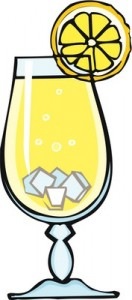 You may really look forward to happy hour or that before dinner drink. Time to relax and enjoy the company of friends or family. Not necessarily a bad thing. Unfortunately, it’s way too easy to underestimate or forget about the calories lurking in that glass.
You may really look forward to happy hour or that before dinner drink. Time to relax and enjoy the company of friends or family. Not necessarily a bad thing. Unfortunately, it’s way too easy to underestimate or forget about the calories lurking in that glass.
Calories You Drink Don’t Fill You Up
When you drink your calories your body doesn’t actually feel satisfied. Except for perhaps milk or other protein drinks, fluid intake doesn’t typically trigger production of the hormones that tell your brain that you’ve fed your stomach. Most liquid calories don’t produce “satiety” or the feeling of “being full,” which your brain takes as the cue to stop eating.
This is especially true if you’re slowly sipping your drink — but research has shown that even if the temporary bloat you feel after rapidly downing a beer is no substitute for satiety.
(FYI: even if you don’t feel full, the alcohol you’ve drunk still has 7 calories per gram compared to 4 calories per gram for carbohydrates and protein and 9 calories per gram for fat.)
Beer: Light Or Not
Even light beer – although a calorie saver – still has calories that add up. Light beer isn’t like diet soda – calorie and fat free. It does have fewer calories than regular beer but it still has, on average, 100 or more calories for 12 ounces (yes, there are light beers with fewer calories – these are average calorie counts). Regular beer ranges from about 140-200+ calories, depending on the type of beer.
Alcohol And Mixers
An average shot (1.5 oz) of 80-proof alcohol has around 96 calories. The higher the alcoholic content (proof), the greater the number of calories.
- 80-proof vodka (40% alcohol; the most common type) has 64 calories per 1oz
- 86-proof vodka (43% alcohol) has 70 calories/1 oz
- 90-proof vodka (45% alcohol) has 73 calories/1 oz
- 100-proof vodka (50% alcohol) has 82 calories/1 oz
When you start adding mixers, the calories can more than double.
- 8 oz of orange juice has 112 calories
- 8 oz of tonic has 83 calories
- 8 oz of ginger ale has 83 calories
- 8 oz of tomato juice has 41 calories
How Full Is Your Wine Glass?
Unfortunately, the standard serving of wine (5 oz) and liquor (1.5 oz) is probably smaller than you think.
Most standard servings of wine have 125-150 calories, but the calories can double depending on the size of the glass and how far it’s filled up. Sweet and dessert wines are more caloric than table wine and champagne.
Try filling up a glass –using water—to simulate the amount of wine you would usually pour, and then measure that amount in a measuring cup. You might be shocked to find that the serving you’re used to pouring is double the standard serving size.
Fancy Cocktails May Be The Equivalent Of Dessert
Highly caloric, extremely creative, and often quite large cocktails can actually be desserts in disguise. Chocolaty, creamy, rim coated with sugar cocktails may be delicious, but they’re loaded with calories (even if they have fruit in them).
Jumbo and super-sized drinks with double shots and extra mixers could add up to 1,000 calories or more (a single giant glass of TGI Friday’s frozen mudslide has around 1,100 calories), so don’t forget to factor them in.

Leave a Reply